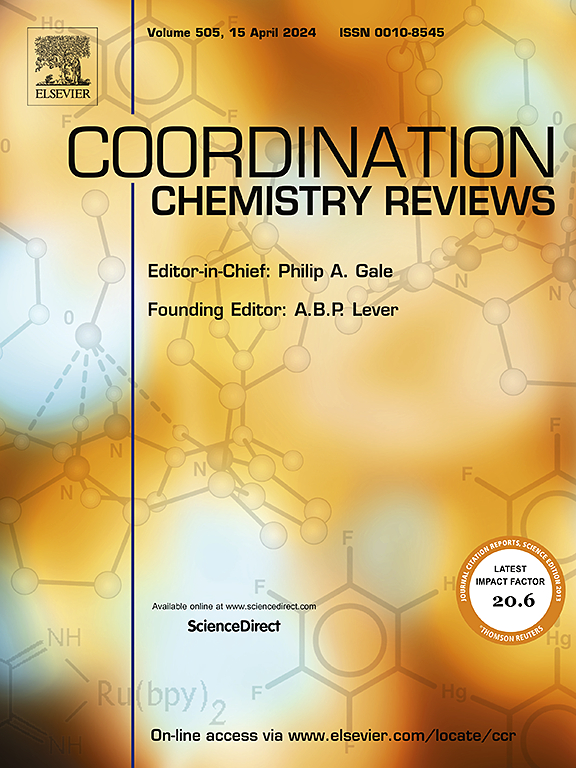Multifunctional pentazole materials: Preparation, structure, and properties
IF 20.3
1区 化学
Q1 CHEMISTRY, INORGANIC & NUCLEAR
引用次数: 0
Abstract
The newest species of polynitrogen compounds, pentazolate anion (cycloN5−), has garnered significant interest from its successful preparation through chemical methods in 2017. This carbon- and hydrogen-free five-membered ring exhibits extremely high energy properties and unique structural characteristics. As the novel polynitrogen compound after N2, N3−, and N5+, this substance can release significant energy during decomposition, only producing environmentally friendly N2. Five equivalent nitrogen atoms form similar binding sites, constructing diverse and colorful pentazolate compounds and derivatives. This review focuses on pentazolate compounds as energetic compounds, multifunctional materials with relevant theoretical simulations and experimental syntheses. The following items are included in this review: (1) achieving purification and large-scale production of pentazolate anion through the use of an iron single-atom catalyst; (2) a variety of metal pentazolate frameworks with zeolite-like structures and a series of energetic coordination polymers that have the potential to be used as explosives; (3) nonmetallic materials with high density, heat of formation, and energy performance, and complexes increasing decomposition temperature to improve physicochemical properties; (4) thermal decomposition mechanism and stabilization strategy dominated by hydration and hydrogen bonding interactions; (5) pentazolate derivatives represented by HN5, FN5, NH2N5, (CH3)2NCHN-N5, N8, and N10; and (6) considerations for future theoretical and experimental explorations. This review introduces a systematic summary and apprehending of pentazolate compounds, aiming to explore their potential as next-generation high-energy and environmentally friendly energetic compounds and applications of multifunctional materials in various fields.

多功能戊唑类材料的制备、结构与性能
最新的多氮化合物,pentazolate anion (cycloN5−),自2017年通过化学方法成功制备以来,引起了人们的极大兴趣。这种无碳无氢的五元环具有极高的能量特性和独特的结构特征。作为继N2、N3−、N5+之后的新型多氮化合物,该物质在分解过程中释放出大量能量,只产生对环境友好的N2。五个相等的氮原子形成相似的结合位点,构建出丰富多彩的五唑酸酯化合物及其衍生物。综述了五唑酸盐类含能化合物、多功能材料及其理论模拟和实验合成的研究进展。本文主要介绍以下内容:(1)利用铁单原子催化剂实现五唑酸阴离子的提纯和规模化生产;(2)具有沸石样结构的多种金属五唑盐骨架和一系列具有炸药应用潜力的高能配位聚合物;(3)高密度、生成热、高能的非金属材料,以及提高分解温度改善物化性能的配合物;(4)水化和氢键相互作用主导的热分解机理和稳定策略;(5)以HN5、FN5、NH2N5、(CH3)2NCHN-N5、N8、N10为代表的五唑盐衍生物;(6)对未来理论和实验探索的思考。本文对五唑酸酯类化合物进行了系统的总结和认识,旨在探索其作为下一代高能环保高能化合物的潜力和多功能材料在各个领域的应用。
本文章由计算机程序翻译,如有差异,请以英文原文为准。
求助全文
约1分钟内获得全文
求助全文
来源期刊

Coordination Chemistry Reviews
化学-无机化学与核化学
CiteScore
34.30
自引率
5.30%
发文量
457
审稿时长
54 days
期刊介绍:
Coordination Chemistry Reviews offers rapid publication of review articles on current and significant topics in coordination chemistry, encompassing organometallic, supramolecular, theoretical, and bioinorganic chemistry. It also covers catalysis, materials chemistry, and metal-organic frameworks from a coordination chemistry perspective. Reviews summarize recent developments or discuss specific techniques, welcoming contributions from both established and emerging researchers.
The journal releases special issues on timely subjects, including those featuring contributions from specific regions or conferences. Occasional full-length book articles are also featured. Additionally, special volumes cover annual reviews of main group chemistry, transition metal group chemistry, and organometallic chemistry. These comprehensive reviews are vital resources for those engaged in coordination chemistry, further establishing Coordination Chemistry Reviews as a hub for insightful surveys in inorganic and physical inorganic chemistry.
 求助内容:
求助内容: 应助结果提醒方式:
应助结果提醒方式:


